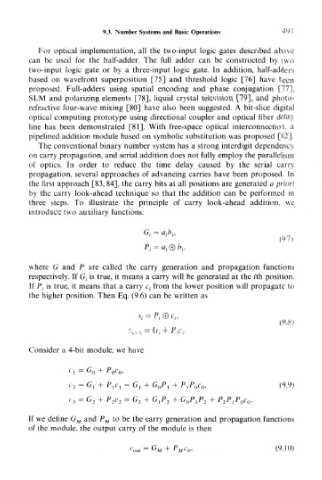Page 506 - Introduction to Information Optics
P. 506
9.3. Number Systems and Basic Operations 49 1
For optical implementation, all the two-input logic gates described above
can be used for the half-adder. The full adder can be constructed by two
two-input logic gate or by a three-input logic gate. In addition, half-adders
based on wavefront superposition [75] and threshold logic [76] have been
proposed. Full-adders using spatial encoding and phase conjugation [77],
SLM and polarizing elements [78], liquid crystal television [79], and photo-
refractive four-wave mixing [80] have also been suggested. A bit-slice digital
optical computing prototype using directional coupler and optical fiber delay
line has been demonstrated [81]. With free-space optical interconnection, a
pipelined addition module based on symbolic substitution was proposed [82].
The conventional binary number system has a strong interdigit dependency
on carry propagation, and serial addition does not fully employ the parallelism
of optics. In order to reduce the time delay caused by the serial carry
propagation, several approaches of advancing carries have been proposed. In
the first approach [83, 84], the carry bits at all positions are generated a priori
by the carry look-ahead technique so that the addition can be performed in
three steps. To illustrate the principle of carry look-ahead addition, we
introduce two auxiliary functions:
where G and P are called the carry generation and propagation functions
respectively. If G, is true, it means a carry will be generated at the ith position.
If P,. is true, it means that a carry c { from the lower position will propagate to
the higher position. Then Eq. (9.6) can be written as
Consider a 4-bit module; we have
(', = GQ + P 0C 0,
c 2 = G, + P lC] - G, + G 0P, + P,P 0c 0, (9.9)
<- 3 = G 2 + P 2c 2 = G 2 + G,P 2 + G 0 P,P 2 + P 2P,P 0c 0.
If we define G M and P M to be the carry generation and propagation functions
of the module, the output carry of the module is then
C OM = GM + P MC O, (9.10)

